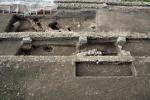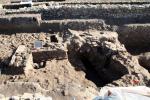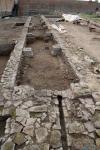Summary (English)
As part of a project to recover and enhance the Swabian and Angevin castle and fortress, preliminary excavations were carried out in the area of the so-called Casoni Angioini. These structures provided accommodation for families of artisans and soldiers from Provence. Charles I of Anjou had the castle built between 1271 and 1282 and promoted their settlement inside the structure. The construction of 65_domus_ pro habitacione incolarum began in about 1275 and seemed to have been completed during 1278. The houses were rectangular, 12.65 m long and 6.32 m wide across the front and formed a dense network of parallel buildings that occupied most of the fortress area. The excavation (fig. 1) brought to light a stratigraphic sequence ranging from the late antique to the late medieval period inside two flanking houses and the alley (_strictula_) alongside them. The houses abutted the east wall of the fortress ex parte Lucerie.
The earliest evidence was a wall, partially uncovered in Casone II, made of bricks in regular courses bonded with mortar. After it went out of use, this wall was partially used firstly as the wall of an earth grave (T4) and later as the foundation for a building of which only two perpendicular walls survive. The grave, on a NW/SE alignment, had no covering and contained the remains of an adult female individual. There were no grave goods (fig. 2).
Two earth graves (T2, T5) were uncovered in Casone II, relating to the area’s subsequent use as a cemetery. Both graves were on a NW/SE alignment and were dug into the floor of a room that was probably of late antique date. Based on the stratigraphy and type of burial, one of an infant, these graves can be dated generically to the early medieval period.
It was probably during this period that the late antique room partially collapsed, its remains were identified immediately to the north-east, both in Casone II and in the alley (_strictula_) between the two Casoni.A third cemetery phase was attested by two more burials (T1, T3) in Casone II. Both were on a NW/SE alignment and were of the “a cassa” type. Tomb 1 contained an infant burial, the badly preserved skeleton no longer articulated. Tomb 3, was covered by large fragmented tiles, and contained the remains of a male infant also without grave goods.
In a successive phase, the walls present in the area were heavily robbed, as shown by the presence of numerous robber trenches that cut some of the structures mentioned above (fig. 3).
Traces of a construction site, an extensive thick layer of lime and several holes relating to structures built of perishable materials, probably date to the late medieval periodIn the Angevin period, thick layers of rubble were documented across the entire excavation area that were dumped to obliterate the earlier structures prior to the construction of the two Casoni. The buildings’ perimeter walls were constructed first. Later, quadrangular structures were built abutting the long walls that had the double function of buttress and support for the system of tubuli that drained water from the roof to a masonry-built drain (fig. 4). The latter ran, sloping east to west, along the north front of the Casoni, and caused a change in use of the space between Casoni I and II.
- Italo M. Muntoni - Soprintendenza per i Beni Archeologici della Puglia
Director
- Antonio De Siena - Soprintendenza per i Beni Archeologici della Puglia
Team
- Giuseppina Caliandro
- Luciano Piepoli
- Paola Spagnoletta
Research Body
Funding Body
- Direzione Regionale per i Beni Culturali e Paesaggistici della Puglia con propri fondi "P.O. 2009 – CAP 7435/01 e Programmazione del gioco del Lotto






![Download [PDF]](/excavation/skins/fasti/images/results/download_sml.png)


